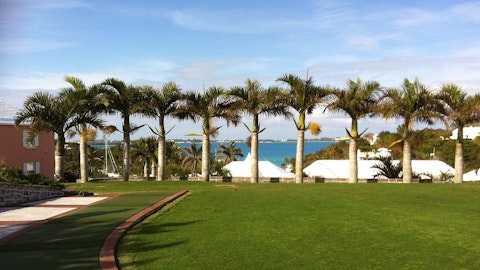Hyperfine, Inc. (NASDAQ:HYPR) Q2 2024 Earnings Call Transcript August 9, 2024
Operator: Good afternoon, and welcome to Hyperfine’s Second Quarter 2024 Earnings Conference Call. [Operator Instructions] As a reminder, this call is being recorded for replay purposes. I would now like to turn the call over to Marissa Bych from Gilmartin Group for introductory disclosures.
Marissa Bych: Thank you for joining today’s call. Earlier today, Hyperfine Inc. released financial results for the quarter ended June 30, 2024. A copy of the press release is available on the company’s website as well as sec.gov. Before we begin, I’d like to remind you that management make statements during this call that include forward-looking statements within the meaning of the federal securities laws, which are made pursuant to the safe harbor provisions of the Private Securities Litigation Reform Act of 1995. Any statements contained in this call that relate to expectations or predictions of future events, results or performance are forward-looking statements. All forward-looking statements, including, without limitation, those relating to our operating trends and future financial performance, expense management, expectations for hiring, training and adoption, growth in our organization, market opportunity, commercial and international expansion, regulatory approvals, and product development are based upon our current estimates and various assumptions.
These statements involve material risks and uncertainties that could cause actual results or events to materially differ from those anticipated or implied by these forward-looking statements. Accordingly, you should not place undue reliance on these statements. For a list and description of the risks and uncertainties associated with our business, please refer to the Risk Factors section of our latest periodic filings with the Securities and Exchange Commission. This conference call contains time-sensitive information that is accurate only as of the live broadcast today, August 8, 2024. Hyperfine Inc. disclaims any intention or obligation, except as required by law, to update or revise any financial projections or forward-looking statements, whether because of new information, future events or otherwise.
And with that, I will turn the call over to Maria Sainz, President and Chief Executive Officer of Hyperfine.
Maria Sainz: Good afternoon and thank you for joining us. On the call with me today is our Chief Administrative Officer and Chief Financial Officer, Brett Hale. Our strong performance in 2024 continued in Q2 with a record quarter at $3.6 million in total revenue and a balanced mix of U.S. and international deals. In the U.S., we continued adding flagship accounts to our ramp of early and enthusiastic users. And the pipeline is growing strong. International contributions to revenue were also very healthy in Q2. We are pleased with the engagement and performance of our distribution network. I would like to share that we conducted our first in-person service and product training session for our global partners early in the quarter.
Beyond our strong commercial traction, we achieved several important milestones associated with our innovation and clinical programs. The recently announced clearance by the FDA of our ninth generation AI-powered software marks a critical step forward in the imaging capability of our unique ultra-low field portable brain MRI. We are now able to upgrade the image quality and reduce acquisition times, delivering higher overall clinical performance. Reducing scan times may help us speed up the diagnostic process in certain clinical circumstances like acute care settings, which can be crucial for time-sensitive medical conditions such as stroke where time is brain. Artificial intelligence remains a powerful engine behind our sequence development innovation, and it has been very rewarding to see how our total number of AI-powered marketing authorizations places our company in a leading position on the FDA’s list of artificial intelligence and machine learning enabled medical devices recently published.
On the clinical front, enrollment began in the CARE PMR study in Alzheimer’s program, and it has been progressing well. We are now scanning for the detection of ARIA complications in patients who are taking amyloid-targeting therapy at 3 LEQEMBI infusion program and are in discussions with several other potential study sites. As a reminder, CARE PMR compares portable ultra-low-field brain MRI with a high-field convention MRI to assess the ability of the Swoop system to detect ARIA complications in patients taking amyloid-targeting therapies. And just last week, at the Alzheimer’s Association International Conference, Washington University and Mass General Brigham presented very promising initial data on ARIA detection with Swoop as well as the use of Swoop for monitoring the progression of Alzheimer’s.
The first sponsor was presented by Dr. Okafor from Washington University and included the images of one of the first ARIA cases observed in the study on both a conventional 3 Tesla scanner and the 2 ultra-low-field portable scan. The second hoster presented by Dr. Taylor Kimberly from Mass General Brigham, focused on the quantitative assessment of ultra low-field MRI images compared to conventional high-field MR images in evaluating brain morphometry in Alzheimer’s patients and highlighted a strong agreement in volumes between conventional MR images and some imagers. The authors concluded, given its portability and low operational costs, low-field MRI folks promise as a valuable tool to diagnose Alzheimer’s disease and monitor its progression.
There are real workflow benefits to brining brain imaging closer to patients with Alzheimer’s disease, their clinicians and care partners with the potential to have substantial impact in access, cost and equity in Alzheimer’s care. We expect to significantly optimize workflow and ultimately open up the opportunity for more patients to be monitored and treated safely and efficiently at different types of care. In stroke, ACTION PMR is progressing well. This is a multi-sensory evaluation assessing the use of the Swoop system for the triage of acute ischemic stroke. The initial 100 patients have been enrolled to evaluate acute stroke detection with the Swoop system as compared to CT and conventional MRI. Recently, we announced the publication of our subset of data from this study, providing early evidence that the Swoop system is a promising tool for enabling critical stroke treatment choices in urgent care settings.

The data is published in the August 2024 edition of Annals of Neurology and highlights also low field MRI’s ability to be used as a tissue clock to characterize acute stroke. We look forward to having additional data shared later this year. We also plan to launch the workflow phase of our study to assess the efficiency and economic value of accessible-grade MRI and spoke studies to triage stroke. Now building on the momentum we have across all of our initiatives, I want to provide more detail on the acceleration we expect to see in our business as early as 2025. We have also detailed these catalysts on Slide 12 of our most recent investor presentation deck, which you can find on our Investor Relations site. As the field of Alzheimer’s care continues to rapidly evolve, we are generating data to support the clinical utility and workflow benefits of the Swoop system for this patient population.
We anticipate that we will be placing Swoop systems in neurology clinics, infusion centers and other Alzheimer’s care programs commercially in the second half of 2025. The stroke opportunity will open up the placement of Swoop units in EDs and hub-and-spoke stroke networks. Stroke triage is creating significant challenges in EDs across the U.S., resulting in considerable clinical and economic burden. With the use of Swoop system provides a readily available MRI tool to triage stroke in EDs and spoke sites, positively impacting stroke care and costs. We anticipate EBIT placements to be incremental to critical care placements in the hospital setting, and we expect revenue contribution from this opportunity starting in the second half of 2025.
We have also been pursuing opportunities outside of the hospital. I would like to now provide detail on our entrance into the neurology office setting as a new and additional business for Swoop system placement. Our initial step in our plan to enter neurology offices is obtaining accreditation. And we are pursuing expanded outdoor hospital and clinic setting accreditation through the Intersocietal Accreditation Commission, IAC, which we anticipate being completed by the end of this year. Additionally, the American College of Radiology Accreditation recently revised their safety manual to include new language regarding the safety profile and training requirements of low-field point-of-care MRI. We are pleased that major accreditation bodies are now formally acknowledging the importance and emergence of low-field point-of-care MRI.
We are mobilizing resources to support this new opportunity for Hyperfine, and we expect to see revenue contributions from the new office business also in the second half of 2025. Furthermore, international expansion will be another growth driver in 2025 as we will have a full year of our international distribution network in place as well as a potential regulatory approval in India in the second half of the year. Clinical use internationally is similar to what we have seen and trying to do in the U.S., and we anticipate Swoop system placements in international markets across multiple types of care, including adult and pediatric care settings. The diverse Swoop system adoption expansion and growth opportunities ahead of us are all large and compelling.
The fundamentals of our business are solid, built on our proprietary technology, our leadership position, our track record of innovation, our healthy gross margin profile and strong spending discipline. We have multiple large and near-term opportunities to grow from our strong foundation, and I am confident we will see significant business acceleration in 2025 and beyond. I would now like to turn the call over to Brett to review our performance in the quarter.
Brett Hale: Thank you, Maria. Turning to our financial results for the second quarter of 2024. Revenue for the quarter ended June 30, 2024, was $3.6 million, up 7% compared to the second quarter of 2023 and up 10% compared to the first quarter of 2024. Gross profit for the second quarter of 2024 was $1.8 million compared to $1.4 million in the second quarter of 2023, resulting in a record gross margin of 50%. R&D expenses for the second quarter of 2024 were $5.9 million compared to $5.3 million in the second quarter of 2023. Sales, general and administrative expenses for the second quarter of 2024 were $6.7 million compared to $7.8 million in the second quarter of 2023. As outlined by Maria, we continue to invest in the areas of innovation and operate lean.
Net loss for the second quarter of 2024 was $10.1 million, equating to a net loss of $0.14 per share as compared to a net loss of $10.6 million or a net loss of $0.15 per share for the same period of the prior year. The improvement in net loss was a result of our strong revenue, expanding gross margin and continued spending discipline and cost-saving initiatives implemented across the business over the past year. Our cash burn in the second quarter of 2024 was $9.4 million. And as of June 30, 2024, we had $53.8 million in cash and cash equivalents on our balance sheet. Turning to guidance. We are raising our revenue outlook for the full year 2024 to a range of $13 million to $16 million. We expect continued commercial progress in the second half of the year with the expectation of some summer seasonality impact, given our increased mix of international revenue.
We are driving healthy margins even at small scale, and we were pleased to drive a record 50% gross margin in the second quarter of 2024. We have a differentiated and attractive profile among medical imaging companies and companies that are scale, and we are optimistic that we will surpass 50% gross margins comfortably and sustainably over time as we realize the commercial acceleration from our growth catalysts. For the full year 2024, we continue to expect gross margins to be in the range of 45% to 50%. We continue to anticipate total cash burn of approximately $40 million for the full year 2024. We expect our cash burn to be below 2023 levels, and we will execute this plan while sustaining investments in our key growth drivers. We also continue to see a cash runway for the business into early 2026, funding the commercial realization of the growth catalyst Maria mentioned previously.
At this point, I’d like to turn the call back to Maria for closing comments.
Maria Sainz: Thank you, Brett. I’m proud of the strong progress that Hyperfine team made in the second quarter and year-to-date. We’re advancing our growth initiatives and delivering record revenue. I remain very optimistic in our ability to execute and deliver significant business acceleration in 2025 and beyond. Just last week, I was able to witness first hand the interest and see the outcome for what portable MRI can represent in Alzheimer’s care. The Alzheimer’s disease field is an area of huge unmet need with significant investment from the pharma industry, global policymakers and advocacy groups. It is rapidly evolving and the focus on access, equity and workflow simplification is often in the center of the debate, which reinforces how we assess the fifth and the potential for the Swoop systems. With that, I want to thank you for your time and open up the line for questions.
Q&A Session
Follow Hyperfine Inc. (NASDAQ:HYPR)
Follow Hyperfine Inc. (NASDAQ:HYPR)
Receive real-time insider trading and news alerts
Operator: Thank you. [Operator Instructions] Your first question comes from the line of Yuan Zhi from B. Riley. Please go ahead.
Yuan Zhi: Hi, Maria, congrats on a very good quarter. And thank you for taking our questions. I got a couple of questions here. First, I would like to hear the reasons for you to update the guidance here. Was it driven by your U.S. sales force? Or was it kind of partly contributed by the international sales? And then if you can comment on your confidence reaching the guidance here, that would be great. Then I have another follow-up.
Maria Sainz: Sure. Thank you, Yuan. So clearly, the first half has been a strong first half, and we’re closing the first half with strong momentum across both our U.S. and our international channels. And that has gotten us to really raise the guidance with confidence that we can deliver a little bit more than we thought before in light of how well the international channel has responded with our support, but also the strength of the pipeline in the U.S., both in adult and pediatric hospitals, which we have been mentioning for the last few quarters.
Yuan Zhi: Got it. Got it. So for – it was great to see the hoster presentation at AIC and I heard positive feedback on the product demonstration. I’m just curious, have you thought about the timeline to convert some of the leads from AIC into others?
Maria Sainz: Great question. And yes, we were very, very pleased with the reception at AAIC of our technology, the image quality, the patient experience. We had over 300 of the participants who volunteered and waited in line to get scanned with our device to experience first hand what that would represent to their patients, and we had many of them also checking with Dr. Ngo, our Medical Officer, in our viewing station and look at the images and the quality of the images. It is a little early to know how quickly a lot of this interest will funnel into orders, but we definitely came home with a long list of follow-up items across a lot of interesting opportunities. Definitely, we uncover some of the larger LEQEMBI programs that are out there that would be great targets for us to continue to collect ARIA data.
There was interest from some of the other industry players that we’re following up on. There was renewed and continued interest from some of the ADRCs we had already contacted that are willing to go a little bit faster and getting involved with our technology. There was also interest around doing community-based screening using our device to keep filling the funnel of potential likely candidates for the ATT drug therapy. So we are anticipating, and we’ve chosen to add a slide to our investor deck that, really, the entry commercially into Alzheimer’s is really right around the second half of next year. So we are really seeing it as a growth – as a revenue contributor starting about that time frame.
Yuan Zhi: Got it. One last question before I jump back to the queue. I’m curious, any updates we should be watch at the CTAD clinical trial in Alzheimer’s Disease Conference in Madrid at the end of October?
Maria Sainz: Yes. Great question. And of course, that is our next very important Alzheimer’s meeting, that is the CTAD, so Clinical Trials in Alzheimer’s Disease, which, as you said, is at the end of October in Madrid. We will have additional data presented from the Washington University Group, which is the same one that presented on one of the very first ARIA cases on our technology side by side, really the same case on a 3T technology, which is the encouraging sort of token that starts pointing to the merit of our technology in detecting ARIA. So expect to see more data presented by Dr. Okafor again in Madrid late October.
Yuan Zhi: Got it. Great. Thanks for taking our questions. And again congrats on a good quarter
Maria Sainz: Excellent. Thank you very much.
Operator: There are no more questions at this time. That concludes our Q&A session. I will now turn the call back over to Maria Sainz for closing remarks. Please go ahead.
Maria Sainz: Thanks to all for joining us here today. We look forward to further updates from Hyperfine next quarter.
Operator: Ladies and gentlemen, that concludes today’s call. Thank you all for joining. You may now disconnect.
Follow Hyperfine Inc. (NASDAQ:HYPR)
Follow Hyperfine Inc. (NASDAQ:HYPR)
Receive real-time insider trading and news alerts





